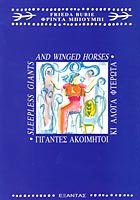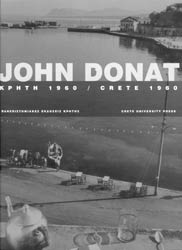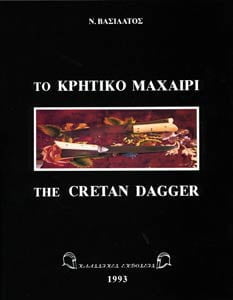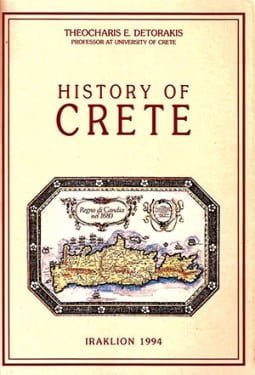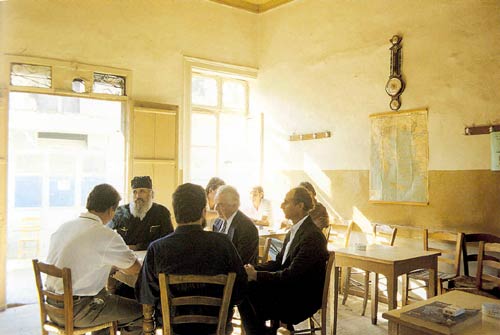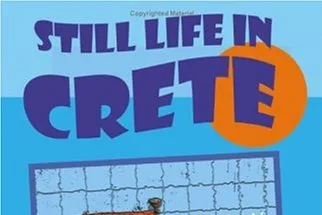With the Shepherds of Crete
Where Zeus became a Man (with Cretan shepherds) by Sabine Ivanovas
Efstathiadis Group Editions. ISBN 960 226 584 1
Sabine Ivanovas is from Germany. She lives in Milatos, Crete since 1992. In Milatos she met the shepherds from Mountain Idi (Ida or Psiloritis), who spend their winters with their sheep near the green coast, while snow covers the mountain pastures. Fascinated by the pride and traditions of these men of Crete she followed them with her camera and recorded scenes of a life of ancient ways that may have vanished in a few years from now.
This fascinating book is trilingual (english, german, greek) with 345 photographs and 2 maps.

CONTENTS
Introduction.
1. Shepherds on Mount Ida – Tradition and Change
2. Men: Here they can still be Dare-Devils.
3. Women – And not only ‘Erondas’
4. Mizithra – The Most Sensuous Cheese of the World
5. Shearing Sheep – The Work of the ‘Kouretes’
6. Celebrations: With Lyra and Laouto
7. Chimadio – From the Mountains down to the Seashore.
Epilogue
Glossary
Maps
INTRODUCTION
This book is supposed to tell not only about Crete, her awe-inspiring long past or the plenty-fold beauty of her landscape. Above all I would like to give some impressions of the people who live on this island, who are in many ways still perceivably the heirs of their great history and who live in the wonderful nature of this smallest of all continents.
Since I have moved from Germany to Crete in 1992, the Cretans – equally those who live near the sea and those who live in the mountains – have always fascinated me with their generous hospitality and the open way they welcome strangers like me to share their lives. Originally I chose Crete as my place of living because the climate improved my weak health. Now I know that I want to stay because I found a new home here. For this I am very thankful to all Cretans who magnanimously welcomed my family and me to their country, especially the people from our village Milatos who never tired of telling me that I am one of them now. I feel very honoured with this.
Here in the vicinities of Milatos I also happened to meet the shepherds from Mount Ida who introduced me to another part of the island I had until then not yet dared to explore: the mountains.
When I went up for the first time with my family to go beyond Zoniana, on a stony lane that seemed to lead towards the end of the world, someone asked us proudly: “How do you like our mountain?”
In this book I also want to show what seems to me the only possible answer to this question: Mount Ida is fantastic, the crowning peak of an island full of variety and beauty. From the heights of Mount Psiloritis all her glory lies at your feet like a magic carpet which has the whole life woven into its material.
For making this experience possible for me I would like to thank the people from Zoniana, especially the family Parasyris with father Stelios (called Polostelios ‘, meaning something like: Stelios, of many talents) with his wife Irini and their children Eleni, Dimitris, lannis, Tassos, Vangelis as well as their other relatives, who have shown and explained to me what the life of the shepherds from Mount Ida looks and feels like. In their company I experienced for the first time the distinctive peace and stillness of a daily life with sheep, again and again they answered my endless questions and told me so many wonderful stories.

I would also like to express my gratitude towards the people from Anoghia, especially the family Kounalis with father Vassilis (called ‘Vassilikos’, apart from being derived from his first name it also means ‘the royal one’) with his wife Kalliopi and their children Jana, Jorgo and Aris. In their company I experienced how intensely alive a seemingly deserted solitude like Xeraxyla (between Milatos and Neapoli) can feel through the heartiness of its inhabitants, and also that you can only understand the mystery of the Idean Cave when looking at it from the perspective of the Milatos on the border of the Nida-plain.
In the few years I have been living here I have already seen the disappearance of some old traditions. Nevertheless I hope and wish for the Cretans to be able to keep the power and pride in their independence and originality for the future.
A real European Community can only exist, 1 think, if each of us who live in it keeps his or her characteristics and respects at the same time the individuality of the others. So, speaking from Crete the often so-called ‘cradle of Europe’, I wish that we may perceive each other with respect and interest, something I would also like to express in this trilingual book.
To come to know the original lifestile of the Cretans whoever is interested ought to venture into the heart of the island, too. I can also highly recommend a holiday near the sea in spring (see chapter 7).
Making holidays where the shepherds live is especially recommendable for people who enjoy quiet and peaceful days. There is no need for fearing language-problems: many Cretans can speak a little English and everybody enjoys talking with hands and feet if necessary.
MIZITHRA – THE MOST SENSUAL CHEESE OF THE WORLD (sample from the book)
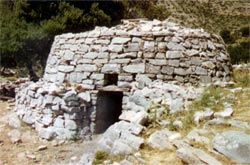
…”Ella mesa! – come in!” Zacharis calls me when my shadow appears in front of the door. I bend down to look into the dark opening. Nothing – from the brightness of the morning I can’t make out anything. I bend down even more and walk slowly forward. My shoulders nearly meet the doorframe.
Then I’m inside of the round womb of the mitato, my eyes slowly adjust to the darkness. Next to a small fire on the outer border of the earth floor Zacharis sits on a round stone bench following the inside curve of the vaulted stone hut, stirring with calm, sure movements in a big copper cauldron that sits in an opening of the bench over the fire. The small gaps in between are filled with still humid, fresh clay (Zacharis makes cheese for the first time today in this season) so that only the lower part of the cauldron is touched by the fire.
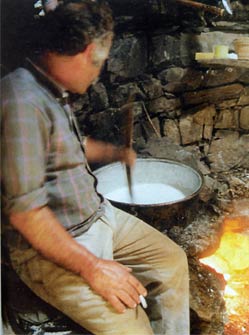
Time and again soft billows of smoke rise from the slightly damp brushwood feeding the fire and Zacharis calmly rubs his burning eyes now and then. Certainly it would be easier to work with a gas cooker, but Zacharis can’t make up his mind yet to give up the old tradition. One or two more years…
While we sit and talk quietly, the creamy, foamy milk in the cauldron starts steaming slightly. Now the time has nearly come and our conversation dies away. The fire has burnt down to silent ambers, the soft dripping of the already finished kefalotiria (head-cheese) from a wooden board on the wall is the only background for the muted rubbing of the stem of a palm leaf Zacharis uses for stirring the fragrant milk. At last he places the stave from the cauldron crosswise over it, spreads the embers a little and stoops to fetch the baskets he will need for making mizithra. He puts them in his reach on the bench, pushes the big milking-bucket into the middle of the mitato and places a double wooden board over it with a gap in the middle so the whey can drip off. Finally he sets two mizithra baskets on the gap.
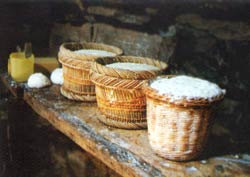
With his next gaze into the softly steaming cauldron he says quietly: “Tora ejine – now it has turned out.” Once again he takes the stirring stave to circle it carefully along the inner rim of the cauldron, cuts with a few movements the curdled milk so that the whey separates in clearer traces from the dense white of the newborn mizithra.
Zacharis lifts the stave from the womb of the cauldron, makes the sign of the cross over the bright circle of the new cheese, smiles out of gratitude before God who has made his work succeed. Filled with awe I forget my camera. Here I discover a kind of vital faith that would do honour to every church. Holy art, the alchemy of cheese-making.
Zacharis takes the big perforated ladle from a hook in the wall, makes again the sign of the cross over the cauldron and starts cheerfully to fill the first basket. Steam rises and the shepherd carefully washes a spoon and a plate in the hot dripping whey. He fills the plate with a generous ladle of hot mizithra and hands it to me. “Kali orexi! – good appetite!”
That’s what I have after all this ambrosial, sweet fragrance that’s filling the mitato. While the first spoonful of heavenly soft, warm mizithra melts in my mouth I wonder if this delicious feeling of well-being in the dark womb of the mitato isn’t just bound to awaken the earliest memories of childhood. And I remember a totally different episode with warm mizithra (a female cheese in Greek by the way – and which woman wouldn’t wish to be so warm sweet and nourishing…), a story from the other end of life:
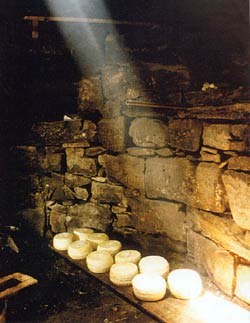
Once I visited the old Konstantinos Sarris in our village (he died in 1996 at the age of 96, until the end a proud Cretan), when he was already quite weak and could hardly walk any more. I told him of my visit in Xeraxyla with Vassilikos where I had eaten warm mizithra, too. He nodded thoughtfully and said: “I’m an old man now and don’t desire women any more. But to eat warm mizithra just one more time …”
One week later I brought him a dish of warm mizithra from Xeraxyla. He dipped the spoon into the bowl and lifted it deliberately to his lips. I’ll always remember his distant smile while he let the mizithra melt in his mouth. He didn’t eat more than that. Two months later he died in his house without ever leaving it again…
Meanwhile the sun has risen high into the sky and penetrates the smoky darkness from the hole in the middle of the mitato’s dome. White fog is wavering in the shaft of light, soaking the last few days’ outcome of mizithres that are drying on a wallboard with supernaturally translucent white…
Continued in the book: Where Zeus became a Man (with Cretan shepherds) by Sabine Ivanovas
© explorecrete.com All Rights Reserved. Reproduction or copying without permission is prohibited.

